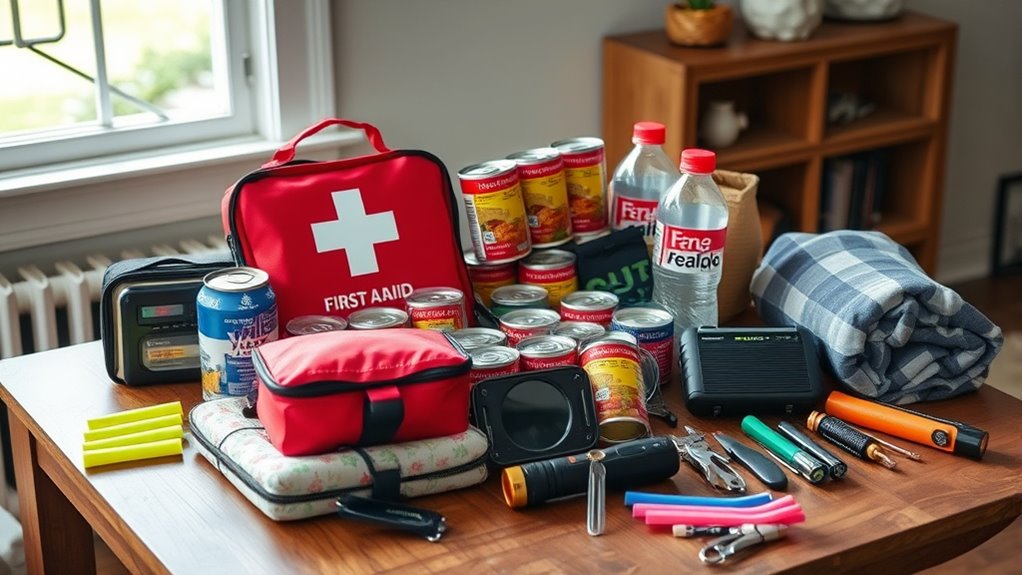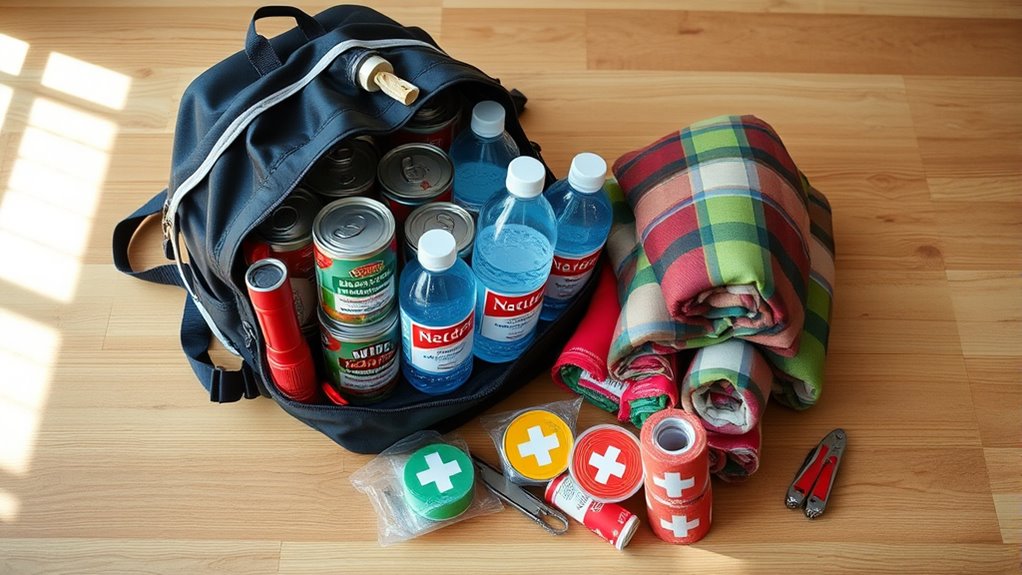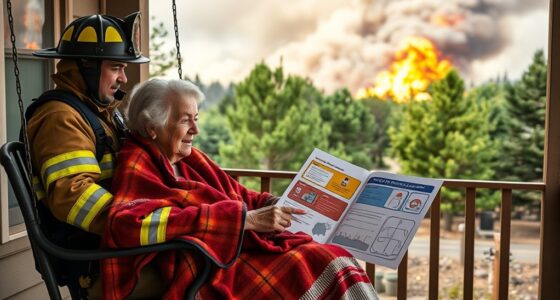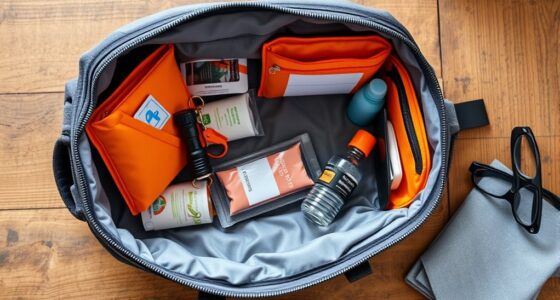To prepare your home emergency supply kit for disasters, gather non-perishable foods like canned goods, dried fruits, and energy bars, along with a manual can opener. Include communication devices such as a battery-powered or hand-crank radio, fully charged mobile phones, extra batteries, and walkie-talkies. Add safety items like flashlights, whistles, and a list of emergency contacts. Keeping these essentials organized will help you respond effectively—continue exploring to guarantee your kit covers all your needs.
Key Takeaways
- Stock non-perishable foods, water, and comfort items to sustain household members for weeks without refrigeration.
- Include essential communication devices like radios, charged phones, and backup power sources for updates and coordination.
- Prepare safety tools such as flashlights, whistles, and first aid supplies for navigation and emergencies.
- Ensure all items are lightweight, easy to store, and accessible, with regular updates and checks.
- Personalize your kit with important contacts, favorite comfort foods, and instructions tailored to your household needs.

Have you ever wondered what essentials you should pack for an emergency? Preparing a home emergency supply kit means thinking ahead about the basics you’ll need to stay safe and self-sufficient during a disaster. One critical aspect is ensuring your food storage is sufficient. You should include non-perishable items like canned goods, dried fruits, nuts, and energy bars, which can last for weeks without refrigeration. Don’t forget a manual can opener if your supplies come in cans, and consider adding some instant meals or freeze-dried foods that are lightweight and easy to prepare if you need to conserve water or fuel. It’s also wise to include a variety of foods to meet nutritional needs and keep your energy levels stable. Storing enough food for everyone in your household, along with a small stockpile of treats or comfort foods, helps reduce stress during an emergency. Incorporating mindfulness techniques such as deep breathing or visualization can help manage stress and maintain calmness during crises.
Along with food storage, communication devices are crucial for staying informed and connected. Your kit should include a battery-powered or hand-crank radio so you can receive alerts and updates from local authorities, even if your power goes out. A fully charged mobile phone with extra batteries or portable power banks can keep you in touch with loved ones and emergency services. It’s smart to have a list of important phone numbers written down in case your devices become unusable. Consider adding a whistle to signal for help if needed, and a flashlight with extra batteries to navigate safely in the dark. Emergency communication isn’t just about staying in touch; it’s about receiving critical information that can guide your next steps. If you have a two-way radio or walkie-talkies, they can be invaluable for coordinating with family members or neighbors when conventional communication lines are down.
Frequently Asked Questions
How Often Should I Update My Emergency Kit?
You should update your emergency kit regularly to guarantee it’s ready when needed. Follow a maintenance schedule, ideally every 6 to 12 months, to check expiration dates and replace expired items. Conduct a kit review frequency to confirm all supplies are intact and functional. This routine helps you stay prepared, avoiding shortages or unusable supplies during an emergency. Regular updates give you peace of mind, knowing your kit is always ready.
What Items Are Most Essential for a Family With Infants?
Think of your emergency kit as a lifeboat, especially when caring for infants. You’ll want to include infant feeding supplies like formula, bottles, and snacks, along with baby health essentials such as thermometers, medications, and wipes. These items guarantee your little one stays safe and comfortable during emergencies. Prioritize these essentials so you’re prepared to protect your baby’s wellbeing, no matter what unexpected situation arises.
How Can I Store My Emergency Supplies Safely?
To store your emergency supplies safely, choose a cool, dry, and easily accessible location. Use sturdy, airtight containers to protect water purification items and keep fire safety equipment like fire extinguishers visible and maintained. Label everything clearly, and regularly check supplies for expiration. Consider a dedicated emergency kit cabinet or waterproof bins, ensuring you can quickly access essentials during a disaster while keeping them protected from damage.
Are There Recommended Kits for Pets?
Oh, of course, your pet deserves a kit just as fancy as yours, right? Luckily, there are recommended kits that include pet food, veterinary supplies, and essentials like a leash and medications. These kits guarantee your furry friend stays safe and fed during emergencies. Don’t forget to tailor the kit to your pet’s needs, so they’re comfortable and cared for, no matter what chaos unfolds.
What Should I Include for Long-Term Power Outages?
For long-term power outages, you should include essential items like a battery-powered radio to stay updated and a solar-powered charger to keep your devices running. Stock up on extra batteries, flashlights, and portable power banks. Don’t forget non-perishable food, water, and basic first aid supplies. This setup guarantees you stay informed, connected, and safe until power is restored.
Conclusion
By assembling your emergency supply kit, you’re building a safety net that catches you when disaster strikes. Think of it as your personal lifeboat in a storm—ready to carry you through turbulent times. Stay prepared, stay calm, and keep your kit updated, so you’re never caught off guard. Remember, a little preparation today can be the anchor that keeps you steady when the waves of trouble come crashing in.









